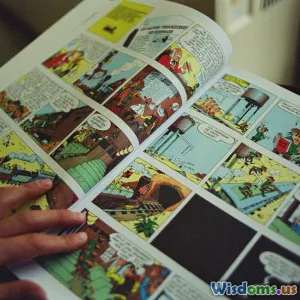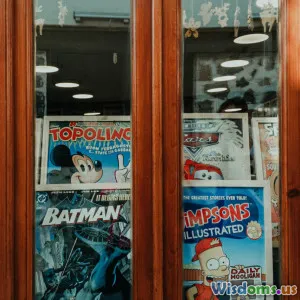
The Rise of Graphic Novel TV Adaptations: Trend or Passing Phase?
10 min read Explore the surge of graphic novel TV adaptations and whether it's a sustainable entertainment trend or just a fleeting phase. (0 Reviews)
The Rise of Graphic Novel TV Adaptations: Trend or Passing Phase?
Introduction: A New Era of Storytelling
Over the past decade, television has witnessed a remarkable influx of graphic novel adaptations. From the gritty realism of The Boys to the nostalgic charm of Archival Print, streaming platforms and networks have keenly tapped into this rich source material. This phenomenon begs the question: Is the surge in graphic novel TV adaptations a genuine evolution reshaping visual storytelling, or is it merely a temporary reaction to the explosion of comic book popularity?
Understanding this trend requires dissecting the appeal and challenges of graphic novels transformed into serialized television, the creative liberties and successes of various adaptations, and assessing the market and audience demand projections for the coming years.
The Appeal of Graphic Novels as TV Source Material
Rich Storytelling and Complex Characters
Graphic novels often explore layered narratives with deeply developed characters, combining textual and visual elements to deliver immersive storytelling. This narrative complexity aligns well with long-form TV storytelling, enabling adaptations to offer detailed world-building and character evolution over multiple episodes or seasons.
For instance, HBO's Watchmen adaptation dives deep into sociopolitical issues, expanding from its original comic roots while maintaining a visually rich and thematically complex narrative. The format allows for nuanced depictions that movies might otherwise condense.
Visual Aesthetic Advantage
A unique trait of graphic novels lies in their distinct visual styles, which immediately grab viewer attention. TV adaptations can leverage these stylistic advantages through innovative cinematography, special effects, and production design, offering audiences a fresh visual experience compared to traditional dramas.
The Umbrella Academy, adapted by Netflix, retains the comic’s eccentric visual tone and quirky character designs, striking a balance between fantastical elements and human emotion. This visual fidelity often wins over loyal comic fans and newcomers alike.
Built-In Audiences and Brand Recognition
Graphic novels often come with pre-existing fanbases that provide a reliable audience base at launch, making production a seemingly safer investment for studios. For example, Amazon’s commitment to adapting Neil Gaiman's Sandman capitalizes on the cult following amassed since the graphic novel's release in the late '80s.
This fanbase also triggers organic promotional momentum on social media platforms and communities, propelling word-of-mouth buzz crucial to streaming success without exorbitant marketing costs.
Success Stories Fueling the Trend
The Umbrella Academy: Defying Genre Constraints
Netflix's The Umbrella Academy blends superhero tropes with family drama and dark humor, mirroring the hybrid genre experimentation that graphic novels are known for. The series has earned critical acclaim and viewer loyalty, making it an evergreen example proving that graphic novel adaptations can resonate broadly.
Its leaders, the showrunner Steve Blackman and the comic’s original creator Gerard Way, emphasize collaboration, ensuring the narrative's integrity complements television’s episodic nature.
The Boys: A Gritty Deconstruction
Amazon Prime Video's The Boys offered a refreshing counterpoint to traditional superhero stories by exposing the dark underbelly of fame and corporate power. Its success skyrocketed interest in mature, satirical stories drawn from graphic novels, garnering record-breaking streaming numbers and multiple Emmy nominations.
This series demonstrates the appetite for mature content, complex moral ambiguity, and genre-bending presented in graphic novel TV adaptations.
Others Worth Noting
The Sandman (Netflix) and Invincible (Amazon Prime) further bolster the genre's viability, blending fantasy, horror, and superhero elements that appeal to a wide demographic.
Emerging adaptations like Y: The Last Man and DMZ indicate an ongoing commitment by the industry to mine graphic novels as abundant and diverse storytelling wells.
Industry Insights: Why Are Studios Investing?
Economic Factors
According to a report by Grand View Research, the global graphic novel market is expected to grow at a CAGR of 7.6% between 2022 and 2030. This expanding market signals increasing demand for graphic novel stories, which studios are eager to translate into scalable IPs for streaming platforms.
Moreover, graphic novel adaptations often require moderate budgets compared to big superhero franchises while promising high audience engagement, making them attractive financial bets in an increasingly competitive TV landscape.
Audience Behavior and Streaming
Post-pandemic viewing habits are shifting among global audiences, who crave diverse and engaging content. The binge-worthy format of many graphic novel stories fits well with streaming consumption patterns, with loyal viewers taking time to digest complex narratives over time.
Data from Nielsen highlights a surging interest in fantasy and sci-fi series, genres deeply intertwined with comic storytelling conventions.
Creative Potential and Franchise Building
Studios perceive graphic novel adaptations as rich mediums for franchise building, often ripe for spin-offs, merchandise, and cross-media extensions. The distinct narrative identities of source materials allow for expansive storytelling universes.
Marvel and DC, while dominant, are being joined by independent publishers like Boom! Studios and Image Comics, providing novel content to refresh and diversify screen entertainment.
The Challenges of Graphic Novel Adaptations
Adaptation Pitfalls: Balancing Faithfulness and Innovation
Translating static visual panels and dialogue bubbles into screen sequences requires creative adaptation. Straying too far can alienate fans; sticking too close may hinder creative cinematic storytelling.
For example, the series Y: The Last Man faced criticism for diverging from the graphic novel's themes, impacting its critical reception and viewer trust.
Navigating Audience Expectations
Graphic novel readers often bring high expectations for authenticity and careful character development. Missing these marks risks disappointing loyal fan communities and generating negative word-of-mouth.
Conversely, general audiences unfamiliar with the source must find the narrative accessible and engaging without prior knowledge.
Saturation Concerns
With streaming giants competing for attention, an oversaturation of comic-adapted content could lead to audience fatigue if quality dips or similar story templates are repeated.
Careful curation and diversity of source material are essential to sustain interest beyond initial curiosity.
Conclusion: An Enduring Evolution or Temporary Trend?
Graphic novel TV adaptations have firmly established themselves as more than a fleeting fascination. They offer uniquely rich storytelling, captivating visuals, and built-in audiences that meet the demands of modern television consumption.
While challenges exist—such as creative adaptation fidelity and avoiding market saturation—the positive indicators in financial investments, audience engagement, and the critical success of multiple adaptations suggest a sustainable trend.
As technology advances and transmedia storytelling evolves, graphic novels are likely to remain a cornerstone for innovative TV content. Emerging voices and diverse graphic novels promise new stories that could transform television’s landscape for years to come.
In essence, this is not just a passing phase but an ongoing renaissance in narrative creativity, where the comic page flows seamlessly onto the screen.
References
- Grand View Research. (2022). Graphic Novel Market Size & Trends.
- Nielsen. (2023). Streaming Trends Report.
- Interviews with Gerard Way and Steve Blackman on The Umbrella Academy (Netflix Maker Studios, 2021).
- Amazon Prime Video & Netflix Press Releases.
Explore more about this vibrant trend and dive into your favorite graphic novel adaptation today—experience storytelling unfolding like never before.
Rate the Post
User Reviews
Popular Posts


















